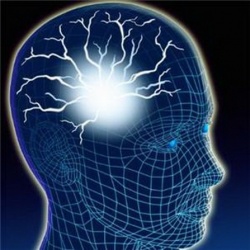Difference between revisions of "Self-essence"
m (1 revision: links) |
|||
| (2 intermediate revisions by the same user not shown) | |||
| Line 1: | Line 1: | ||
[[File:Brain-Powe.jpg|thumb|250px|]] | [[File:Brain-Powe.jpg|thumb|250px|]] | ||
| − | '''[[self-essence]]''' (svabhāva, 自性). An inherent state of being, self-made, self-determined, and changeless. This is a false reality that sentient beings attach to their [[perceptions]]. In truth, nothing has self-essence because everything is constantly changing through causes and conditions. That all [[dharmas]] are without self-essence is the true [[reality]] defined as [[emptiness]]. | + | {{Seealso|Svabhāva}} |
| + | '''[[self-essence]]''' ([[svabhāva]], 自性). An inherent [[state of being]], self-made, self-determined, and changeless. This is a false [[reality]] that [[sentient beings]] attach to their [[perceptions]]. In [[truth]], [[nothing]] has [[self-essence]] because everything is constantly changing through [[causes]] and [[conditions]]. That all [[dharmas]] are without [[self-essence]] is the true [[reality]] defined as [[emptiness]]. | ||
--------------------<br/> | --------------------<br/> | ||
| − | '''svabhāva''' ([[Sanskrit]]). Intrinsic nature, self-being or own-being; a technical term found in early sources but used mainly in later [[Buddhism]] to denote the concept of an [[ātman]] or a permanent and unchanging identity or substratum. In contrast to some pre-[[Mahāyāna]] schools such as the [[Sarvāstivāda]], all [[Mahāyāna]] schools reject the existence of any such intrinsic nature and maintain that all [[phenomena]] are devoid or empty (see [[śūnyatā]]) of any kind of [[svabhāva]]. According to the [[Abhidharma]], the [[svabhāva]] was the unique and inalienable ‘mark’ or characteristic ([[lakṣaṇa]] or sva-lakṣana) by means of which entities could be differentiated and classified. By identifying the [[svabhāva]] of an entity a taxonomy of real [[existents]] could be produced. For example, the [[svabhāva]] of [[fire]] was identified as heat, and the [[svabhāva]] of water was defined as fluidity. Thus the schools of the [[Hīnayāna]], while denying a self of persons ([[pudgala-nairātmya]]) nevertheless accepted the substantial reality of those elements ([[dharmas]]) which composed the world at large, including five [[skandhas]] of the individual subject. Beginning with [[Nāgārjuna]], the [[Mādhyamaka]] undercut this teaching by denying the substantial reality not just of the [[self]] ([[ātman]]) but of all [[phenomena]], a view known as [[dharma-nairātmya]]. All entities were therefore seen as alike in lacking a discrete mode of being or self-essence ([[svabhāva]]), and in sharing instead the common attribute or ‘mark’ of [[emptiness]] ([[śūnyatā]]). | + | '''[[svabhāva]]''' ([[Sanskrit]]). Intrinsic nature, self-being or [[own-being]]; a technical term found in early sources but used mainly in later [[Buddhism]] to denote the {{Wiki|concept}} of an [[ātman]] or a permanent and [[unchanging]] identity or [[substratum]]. In contrast to some pre-[[Mahāyāna]] schools such as the [[Sarvāstivāda]], all [[Mahāyāna]] schools reject the [[existence]] of any such intrinsic nature and maintain that all [[phenomena]] are devoid or [[empty]] (see [[śūnyatā]]) of any kind of [[svabhāva]]. According to the [[Abhidharma]], the [[svabhāva]] was the unique and inalienable ‘mark’ or [[characteristic]] ([[lakṣaṇa]] or sva-lakṣana) by means of which entities could be differentiated and classified. By identifying the [[svabhāva]] of an entity a taxonomy of real [[existents]] could be produced. For example, the [[svabhāva]] of [[fire]] was identified as heat, and the [[svabhāva]] of [[water]] was defined as fluidity. [[Thus]] the schools of the [[Hīnayāna]], while denying a [[self]] of persons ([[pudgala-nairātmya]]) nevertheless accepted the substantial [[reality]] of those [[elements]] ([[dharmas]]) which composed the [[world]] at large, including five [[skandhas]] of the {{Wiki|individual}} [[subject]]. Beginning with [[Nāgārjuna]], the [[Mādhyamaka]] undercut this [[teaching]] by denying the substantial [[reality]] not just of the [[self]] ([[ātman]]) but of all [[phenomena]], a [[view]] known as [[dharma-nairātmya]]. All entities were therefore seen as alike in lacking a discrete mode of [[being]] or [[self-essence]] ([[svabhāva]]), and in sharing instead the common attribute or ‘mark’ of [[emptiness]] ([[śūnyatā]]). |
{{R}} | {{R}} | ||
Latest revision as of 16:50, 29 August 2013
- See also :
- See also :
self-essence (svabhāva, 自性). An inherent state of being, self-made, self-determined, and changeless. This is a false reality that sentient beings attach to their perceptions. In truth, nothing has self-essence because everything is constantly changing through causes and conditions. That all dharmas are without self-essence is the true reality defined as emptiness.
svabhāva (Sanskrit). Intrinsic nature, self-being or own-being; a technical term found in early sources but used mainly in later Buddhism to denote the concept of an ātman or a permanent and unchanging identity or substratum. In contrast to some pre-Mahāyāna schools such as the Sarvāstivāda, all Mahāyāna schools reject the existence of any such intrinsic nature and maintain that all phenomena are devoid or empty (see śūnyatā) of any kind of svabhāva. According to the Abhidharma, the svabhāva was the unique and inalienable ‘mark’ or characteristic (lakṣaṇa or sva-lakṣana) by means of which entities could be differentiated and classified. By identifying the svabhāva of an entity a taxonomy of real existents could be produced. For example, the svabhāva of fire was identified as heat, and the svabhāva of water was defined as fluidity. Thus the schools of the Hīnayāna, while denying a self of persons (pudgala-nairātmya) nevertheless accepted the substantial reality of those elements (dharmas) which composed the world at large, including five skandhas of the individual subject. Beginning with Nāgārjuna, the Mādhyamaka undercut this teaching by denying the substantial reality not just of the self (ātman) but of all phenomena, a view known as dharma-nairātmya. All entities were therefore seen as alike in lacking a discrete mode of being or self-essence (svabhāva), and in sharing instead the common attribute or ‘mark’ of emptiness (śūnyatā).
